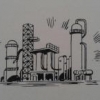Latest Downloads
-
 Water Bath Indirect Heaters
Water Bath Indirect HeatersArt Montemayor - Oct 12 2018 02:35 PM
-
 Petroleum: A Primer for Kansas
Petroleum: A Primer for KansasArt Montemayor - Oct 12 2018 02:27 PM
-
 Spray Tower for Flue Gas Scrubbing Design
Spray Tower for Flue Gas Scrubbing Designankur2061 - May 02 2018 02:31 PM
-
 Selection of Vertical Tanks
Selection of Vertical Tanksankur2061 - Apr 19 2018 07:42 AM
-
 Pressure Drop Calculator for Strainers 1
Pressure Drop Calculator for Strainers 1ankur2061 - Mar 24 2017 02:04 PM
-
 Horizontal Pig Trap System Design Guidelines
Horizontal Pig Trap System Design Guidelinesankur2061 - Jan 14 2017 02:54 PM
-
 Performance Prediction of 3-Stage Propane Refrigeration System
Performance Prediction of 3-Stage Propane Refrigeration Systemankur2061 - Aug 08 2016 02:43 PM
-
 Centrifugal Pump Troubleshooting Checklist
Centrifugal Pump Troubleshooting Checklistankur2061 - Dec 17 2015 08:18 AM
-
 Compressor Troubleshooting Checklist
Compressor Troubleshooting Checklistankur2061 - Sep 08 2015 11:43 AM
-
 Amine Sweetening Unit Preliminary Design
Amine Sweetening Unit Preliminary Designankur2061 - May 19 2015 09:35 AM
Popular Store Titles
 Tank Jacket Calculator
Tank Jacket Calculator
 Specification Sheet Collection
Specification Sheet Collection
 PIPESIZE
PIPESIZE
 Relief Valve Sizing
Relief Valve Sizing
 Rupture Disc Sizing
Rupture Disc Sizing
Chemical and Process Engineering Resources
Submitted Chris Haslego, Nov 21 2011 11:21 AM | Last updated Nov 21 2011 01:29 PM
| Category: | Heat Transfer Technology |
| Question: | How can I prevent this heat exchanger from fouling during turn down? Do you know of a good information source for phosphate solubility versus temperature and fluid velocity? |
| Keywords: | fouling,phosphate,heat,exchanger,shell,tube |
| Answer: | BACKGROUNDA shell-tube heat exchanger (double pass) has cooling water @ about 110-115 0F and weak nitric acid containing some organics @ about 155-160 0F. We treat our cooling water to prevent both phosphate and carbonate scaling. When we pulled this heat exchanger out of service, we observed severe fouling on the outlet side of the cooling water, but very minimal fouling on the inlet of the cooling water. Although our cooling water chemical treatment could use some improvement, I suspect that most of the fouling is due to the fact that when we operate our plant at reduced production rates, we also operate this exchanger with minimal weak nitric velocities. In order not to under cool the weak nitric, thereby causing any organics in the fluid to solidify, we throttle back our cooling water velocities. Now, because the cooling water is moving at 50-75% less than normal operating velocities, and still heating up, we believe lowers the solubility of phosphates in the cooling water, thereby depositing phosphate scaling at the outlet side of our exchanger.RESPONSEI agree completely with your assessment of the situation (this happens often). I see a description of a calculation method for solubility in a book entitled "Properties of Liquids and Gases" by Robert C. Reid (McGraw-Hill...this is a fairly common book). The calculation procedure requires quite a bit of knowledge of the solid substance and frankly, I'd feel better with experimental or practical data (as is mostly the case), but I don't recall seeing anything like that in the past. I'm assuming that you've already eliminated the possibility of removing the set point for the water flow and allow the flowrate of the water to remain the same during scale-down. This would certainly keep the water at a temperature low enough to prevent the deposits. Is this not an option? Or you could always trial and error the water flow down to a rate where the deposits are minimized and then I'd recommend recording that water outlet temperature for future use. |
Forum Quick Links
Tech Q & A Category List
-
 Bulk Solids
Bulk Solids
-
 ChE Outside the Plant
ChE Outside the Plant
-
 Chemical Process Business
Chemical Process Business
-
 Chemistry Basics
Chemistry Basics
-
 Corrosion
Corrosion
-
 Equipment Design
Equipment Design
-
 Experimentation and Testing
Experimentation and Testing
-
 Fluid Dynamics
Fluid Dynamics
-
 Heat Transfer Technology
Heat Transfer Technology
-
 Industrial Utilities
Industrial Utilities
-
 Mass Transfer
Mass Transfer
-
 Physical Property Information
Physical Property Information
-
 Plant Basics
Plant Basics
-
 Plant Economics
Plant Economics
-
 Preparing to Become an Engineer
Preparing to Become an Engineer
-
 Process Control
Process Control
-
 Reactions and Processes
Reactions and Processes
-
 Refining
Refining
-
 Safety
Safety
-
 Separation Technology
Separation Technology
-
 The Environment
The Environment
-
 Thermodynamics
Thermodynamics

 FB
FB



0 Comments